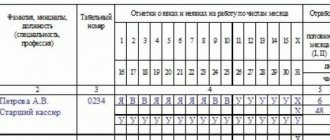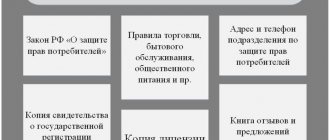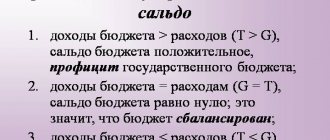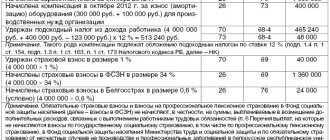What happens
In the context of dynamically developing technologies and the introduction of new programs, basic education does not provide adequate qualifications for personnel, and there is a need to acquire new knowledge and skills. Professional training and retraining of personnel is becoming a necessity. And then the personnel training system comes to the rescue.
Today there are three main types:
- professional training;
- retraining of personnel (retraining);
- advanced training of personnel.
Let's look at each type in more detail.
We draw up a personnel training plan taking into account the specifics of the organization
But sometimes during the work process situations arise when the employee’s level of knowledge may be insufficient, and then the question arises of acquiring new knowledge necessary for work.
Such a need may arise when changing organizational methods of work and improving production. Especially if innovative methods of work differ significantly from previous ones. For example, when an organization switches to electronic document management.
Also when carrying out certain types of work activity, for example, such professions as a driver or a train driver, where regular improvement of the educational level is not only mandatory, but also necessary.
Basic methods
There are methods that are used directly at the employee’s workplace, without interruption from work. That is, he continues to perform his duties outside the workplace when he goes to classes that are conducted outside the organization. As practice shows, the second option gives better results and is more effective.
Personnel training at the enterprise (workplace) is carried out using the following methods:
- Copying. This method is based on the student repeating the actions of a more experienced specialist, as if copying them. The more accurately he repeats, the faster he will develop a new skill.
- Production instruction. It is carried out with each newly hired employee upon employment. It includes information about upcoming functionality, introduces the new position, and makes it easier to understand immediate responsibilities.
- Mentoring. The method is relevant where practical skills are required. An experienced employee takes patronage over a young specialist. The employee learns at his workplace, receiving the support of a mentor. First he tells you how to do it, then he shows you and helps you take the first steps in your work. Prompts if problematic situations arise, and then checks how the trainee has mastered the acquired skills.
- Rotation. To gain new experience, the trainee is temporarily transferred to another workplace. This is typical for enterprises that practice complete interchangeability of employees.
- Delegation. Delegation is understood as the temporary transfer of authority from one person to another in order for the latter to obtain new knowledge and experience. For example, if a manager needs to go on a business trip and he wants to temporarily delegate his powers to another person. But in order for this to pass painlessly, he needs to gradually train this person, for which he can be given some instructions related to the execution of powers.
- Method of increasingly complex tasks. This method is characterized by gradually complicating the tasks assigned to the employee.
Occupational Safety and Health Protocol
Usually this is once a year.
If an employee has been transferred to a new position or has returned to work after a break of more than one year, then an extraordinary knowledge test is necessary. It is convenient to draw up a schedule of training and knowledge testing for the coming year. It may look like this: 3. Check the schedule of medical examinations The validity of medical examinations also needs to be tracked.
Even if this is handled by the organization’s human resources department, an occupational safety specialist needs to monitor the procedure for conducting medical examinations.
The most convenient way is to use special software that will tell you who needs to be sent for a medical examination.
But you can solve the problem manually. At the beginning of the year, it is worth drawing up a calendar plan for medical examinations and approving it with the medical institution with which you have an agreement. The plan might look like this: 4. Ensure the suitability of PPE All PPE has a specific expiration date, which is established by standard industry standards for the free issuance of PPE.
Remedies can be issued: for a certain period, which is usually equivalent to one year; before wear; along the belts; duty officers. For example, if an employee was given PPE for a year, now he must return it.
The employer’s task is to determine the suitability of protective equipment for further use. The Occupational Safety and Health Commission or an authorized employee inspects the personal protective equipment handed over by the employee and determines the percentage of their wear.
If the protective equipment can be used further, this is noted on the personal PPE issuance record card, after which it is returned to the employee. The employee must report the failure of PPE himself.
Testing knowledge and training of workers on labor protection - frequency, test, sample schedule
Development and familiarization of workers with labor protection documents.
The company's labor protection process must be documented.
The documents that regulate labor protection in the company include:
- regulations on labor protection;
- employment contracts, which must include provisions regarding labor protection at the enterprise.
- documents regulating the conduct of labor safety briefings and labor protection training;
- collective agreement;
We recommend reading: New inheritance law 2020
Also, for the purpose of testing knowledge on labor protection, the following documents are required:
- order to create a commission to test knowledge of safe labor methods, protocols of the commission;
- protocols for testing workers' knowledge of labor safety, certificates, logs of protocols and certificates;
- certificates (protocols for testing knowledge) of managers and occupational safety specialists.
Thus, documentation work in the field of labor protection is significant. USEFUL TO KNOW The head of the organization is obliged to issue an order appointing a person to conduct introductory briefings on labor protection, and persons to conduct initial briefings on labor protection in the workplace, repeated, unscheduled and targeted briefings on labor protection.
Step 3. Work in the field of labor protection. According to Part 2 of Art. 212 and art. 214 of the Labor Code of the Russian Federation, the employer is obliged to provide at his own expense, and the employee is obliged to undergo training in safe methods and techniques for performing work and providing first aid to victims at work,
Education outside the workplace
Studying outside the workplace is considered the most effective. These can be frontal classes (lectures), active educational events - conferences and seminars, team work, communication with experts, etc. Let's take a closer look at the main ones.
Lectures
This method is used when you need to quickly convey a large amount of information in a compact form. Lectures are a great way to gain theoretical knowledge where the teaching is conducted by experts. This method has its advantages and disadvantages. For example, the lack of feedback and the inability to determine how well students have learned the material, while the advantages include low financial costs and the presentation of a large amount of information in a relatively short period of time.
Seminars and conferences
This method is more active compared to lectures, since during the learning process there is the opportunity to collectively discuss various aspects of the topic, thereby improving logical thinking. In addition, unlike lectures, classes are held in small groups; it is possible to analyze complex issues using both the experience of the teacher and the students. Based on the results, the effectiveness of personnel training can be assessed.
Business games
The game format involves playing out a situation during which students are asked to solve a given problem.
Trainings
Corporate staff training in a team or training involves setting one task for the group, which they must solve together. To work most effectively with the team, the manager also needs to participate in such classes.
Selfeducation
With this method, the employee independently studies the proposed material. Training can take the form of studying audio or video lessons, or working with special programs. The advantages of this method include: your own pace of passage, lack of reference to a specific place and time of study, saving money and time. The disadvantages are the lack of control, the inability to ask questions about the material studied, and decreased motivation.
Flexibility in learning: changes in plan and creativity
The process of learning, especially independent learning, should not be understood as something permanent and not allowing for change. It should always be carried out intuitively, because no one can know its subtleties and details better than you. Accordingly, if you are faced with the fact that the starting version of the plan is in some way defective, and individual attempts to improve it do not bring the desired result, the plan can and should be adapted.
Adaptation of the curriculum, in fact, is the use of a flexible approach to learning. Adapting a plan means making changes to it that will make it more effective and allow you to fully master the material being studied. If, for example, you decided to study time management, most likely, when drawing up a plan, you might not have taken into account that this technology of organizing and managing time, in addition to the fact that it consists of specific systems and requires the use of special tools, also includes such processes such as goal setting and planning, and without studying them there is no way to fully master time management. There is only one way out - to adapt the plan - expand it, include additional points and allocate time to study goal setting and planning. So, you will have new sources of information, new classes, new tasks and new stages of self-test, in other words, your plan will be adapted to the specifics of the subject being studied.
But there is one more nuance to adapting the plan. It lies not only in a flexible, but also a creative approach to learning. This means that if even at the stage of drawing up the plan you did not see, so to speak, the overall picture, then as you study you will begin to notice that in order to more fully and quickly master the material you may need some tools that you have not thought about before .
For example, the most important information can be depicted as a diagram on a magnetic marker board so that it is always in front of your eyes. If you want to verify something in practice, you can gather friends at home and conduct your own experiment. Not quite understanding how this or that principle works in practice, you can go to the school where you studied, find a teacher you know and ask him to clarify the unclear points. If your family interferes with your studies, you can come up with an “official” lesson for yourself - go to the library reading room and spend the time allotted for the lesson there, or even organize yourself a study room, marking the space with hanging blankets or even sheets of drywall.
A creative approach is the application of non-standard thinking and creativity to the learning process: when faced with a particular problem, “turn on your brain” and figure out how it can be solved if standard methods are not suitable.
And at the end of the lesson it is worth touching on those knowledge, skills and abilities, i.e. competencies that can increase the effectiveness of independent learning and mastery of material.
How to organize staff training
In order to organize everything correctly, a staff training program must be drawn up, which includes certain steps, following which we will achieve optimal results. I suggest drawing up a staff training plan (example).
Step 1. Determine the purpose of study, what exactly are you waiting for. What is the purpose of the event? Perhaps this is increasing employee motivation or creating a talent pool, increasing productivity and quality of work, or preparing employees for a change in business direction.
This is important to know: Increasing the minimum wage in Kuzbass in 2020
Step 2. Select and approve the study format. What forms of staff training will be used. Determining this is important because this factor influences the efficiency of the process. The form can be remote or in the form of direct contact directly with the instructor, but you need to choose based on the convenience and specifics of each organization.
Step 3. Create or select training courses. Some companies have their own training centers where they develop their own training programs. If there are no such centers in your organization, you need to contact special companies that are professionally involved in the development of this product.
Step 4. Find and prepare trainers. To carry out the event, a specialist in training and personnel development is needed. This could be an existing trainer in the organization. It is, however, necessary to periodically check the level of his training and timely send him for advanced training. If there is no such person in the organization, then he is invited from outside. But before you choose someone, be sure to read the reviews and ask for documents confirming their qualifications and level of professionalism.
Step 5. We train the company’s employees. We start by approving the schedule and program. Training organizations can provide a sample staff training program. At the same time, the manager should not withdraw himself from the process. The process must be controlled by someone, for example the HR director: employees will undergo training more responsibly, knowing that management has its finger on the pulse. Based on the results of completion, a staff training protocol is drawn up.
Step 6. Consolidate and evaluate the material covered. To determine how useful and effective the activities were, it is necessary to check the knowledge acquired by employees. This is best done in the form of tests, which will allow you to identify and correct weaknesses in retraining. In addition, if an employee disagrees with the test results, when appealing, the employer will have visual confirmation of the results.
Step 7. Analyze the results and summarize. Based on the results, you can issue questionnaires to employees that will show the level of satisfaction with the course taken. Also, based on the results, personnel reshuffles are often carried out, wages are changed, and a personnel reserve is formed. This is how the employer encourages its employees to further professional development.
Create a plan
Once you are confident that you have successfully completed the three previous stages, you can begin to draw up the plan itself.
To draw up a plan, you can use special techniques (the process of drawing up a plan is outlined in detail on this page) or you can draw up a simple plan, which does not require special knowledge.
An excellent example of a simple plan is a table in the columns of which all the necessary data is entered: deadlines, names of classes and their brief descriptions, a list of tasks to be completed, a check item and the result. This table might look like this:
TRAINING PLAN FOR SEPTEMBER 2020
| DEADLINE | START DATE | NAME (CHARACTERISTIC) | TASKS | DATE OF INSPECTION | RESULT |
| 01.09.2015-07.09.2015 (1 Week) | 01.09.2015 | Preparation of material (examine material) |
| 05.09.2015 | READY |
| 08.09.2015 – 15.09.2015 (week 2) | 08.09.2015 | First lesson (learn the planning process) |
| 13.09.2015 | IN WORK |
Keep in mind that this is just an example. You can make a table or just a list of tasks, add any items and sub-items. The most important thing is that when you turn to your plan, even after taking a break from studying for a few days, you can immediately see and understand what stage of work you are at and what should be done next.
It is best to draw up a training plan for the entire period of studying the required subject. If the training is long-term (lasting several years), you need to draw up a general training plan and then break it down into each academic year. In addition, if you have a desire to build your independent learning process as close as possible to state standards or to the training standard of some educational institution, you can study the Federal State Educational Standards or find the curriculum of the educational institution you are interested in and draw up your plan based on these documents.
Once your study plan has been completed and you feel ready to begin learning, the main step begins—executing the plan. You just need to follow all its steps step by step. But in the process you will receive a lot of new information and vary something. You may have some interesting thoughts about your training and the plan you are following. One way or another, you may encounter a slight difficulty, namely: is it worth following your plan flawlessly or is it possible to change something in it?
Personnel training and development
Currently, the law provides for mandatory training and advanced training only for certain categories of workers. For example, teachers of preschool and school educational institutions, university teachers, medical workers and others should undergo periodic refresher courses. For these specialties, there are specially developed methods, the frequency of assessment of knowledge and completion of courses, etc. has been established.
As for other employees, the manager of the enterprise, as well as the employees responsible for this, are responsible for their level of knowledge and skills. Large companies create special departments responsible for professional training and retraining of personnel. Depending on the specifics of the company’s activities and its scale, its own personnel training system is created, including various methods.
Development and implementation of personnel training programs
Once the training needs have been identified, the budget in hand, the criteria for evaluating performance, and familiar with various training methods, the training department (or training manager) of the organization can begin to develop the programs themselves. Developing a program involves determining its content, choosing forms and methods of teaching.
Depending on the objectives of the training and the category of workers undergoing training, the content of the training programs will vary significantly. We can distinguish four main groups of tasks that are solved during training and have a direct impact on its content. These include:
1. Providing information. In this case, employees are provided with knowledge that will help them do their job better, provide an understanding of the organization’s development prospects, new social programs, benefits, corporate culture, new work standards, which in turn will ensure an increased level of staff commitment to their organization.
2. Development of necessary motor skills and information processing skills. Motor skills are related to the physical aspects of performing professional activities. To teach motor skills, one must not only give the worker information about what he should do, but also show him how he should do the job. To develop and consolidate skills, practice and exercise are a prerequisite. Obviously, a person cannot learn to drive a car, assemble a watch, or operate a machine simply by listening to a lecture, reading a book, or watching a movie; he must practice to master this activity.
The development of motor skills is far from the only goal of personnel training; organizations often have a need to develop students’ skills in working with information. These are skills such as the ability to highlight important information, quickly respond to certain signals or make decisions in non-standard situations, that is, those skills that allow you to solve routine work tasks as efficiently as possible, while minimizing errors and wasted time.
3. Developing interpersonal skills and changing attitudes. Interpersonal skills are essential for workers to successfully interact with others in work and non-work situations. The key skills of interpersonal interaction are establishing psychological contact, listening, persuasion and the ability to competently convey your thoughts to other people. Teaching these skills not only makes it easier to understand other people's behavior, but also helps students develop behaviors, actions, or reactions that make business communication more effective. Like learning motor skills, learning interpersonal skills involves practice and feedback. The teaching method in this case can be training or workshop. In this case, maximum reliance is needed on practicing the material being studied in the form of discussions, role-playing and simulation games. Such classes using video recording as one of the feedback tools are especially effective.
4. Development of the ability to make decisions and analyze problems. In this case, interactive teaching methods are implemented and special emphasis is placed on developing students' group work skills. They learn to analyze problems together with colleagues, compare different points of view, and look for common solutions. In addition, during the training, students learn to identify problem areas, bottlenecks that hinder successful work, and develop ways to solve the identified problems.
When choosing training methods, an organization must, first of all, be guided by the effectiveness of their impact on a specific group of students. In this case, it is necessary to take into account the principles of adult learning. There are four such principles:
§ Relevance. What is discussed during training. Must be relevant to the professional or private life of the student. Adults do not perceive abstract and abstract topics well.
§ Participation. Students must actively participate in the learning process and directly use new knowledge and skills during their studies.
§ Repetition. It helps new things stick in memory and turns acquired skills into habits.
§ Feedback. Learners need to be constantly provided with information about how much progress they have made. Having this information allows them to adjust their behavior to achieve better results.
The most common form of feedback is teacher-assigned grades.
Essence and goals
Personnel training at an enterprise has many important goals:
- introduction of new technologies;
- production optimization;
- simplification of management;
- development of practical skills based on theoretical knowledge;
- preparing employees for qualitatively new changes in the enterprise.
This list is by no means complete and may vary depending on the needs of a particular company. But in almost all cases, management pursues the goal of increasing financial and economic performance or, at a minimum, maintaining the existing level of financial well-being. That is why HR directors prefer not to adapt new employees, but to improve the professional level of existing employees.
Training needs assessment
A training and personnel development specialist must first determine the need for educational activities. The following methods can be used for this:
- analysis of the employee’s personal file - it is established how long ago he received his education, and also took advanced training courses;
- analysis of the employee’s performance - usually carried out when hiring a new specialist;
- collection of applications for study - they can be submitted by department heads, as well as employees themselves;
- certification - based on the results of such knowledge assessment, a special commission can draw up recommendations for study.
This is important to know: Who is responsible for teacher training?
plan schedule for advanced training courses
Schedule for teacher training courses
| ? 347023, Rostov region, Belokalitvinsky district, Gornyatsky village, Teatralnaya st., 1? Head: Petrova Oksana Sergeevna? Phone: +7 (863 83) 56-6-68? Email: [email protected] website |
Employers who actively implement training schedules into company development plans and regularly send their employees to training courses have keenly sensed the economic benefits of the costs incurred and strongly welcome the desire of employees to learn. From the article you will learn:
- why is a training schedule drawn up;
- sample training schedule;
- order approving the schedule for advanced training.
Advanced training – training of personnel in order to master new knowledge, abilities, skills and methods of communication in connection with increasing requirements for the profession or promotion. Standard regulation on an educational institution of additional professional education (advanced training) for specialists, approved. Decree of the Government of the Russian Federation dated June 26, 1995 No. 610 indicates that advanced training is carried out as necessary, but at least once every five years throughout the entire working life of employees. The employer is given the right to determine the frequency of employees undergoing advanced training. According to Article 196 of the Labor Code, advanced training of employees occurs during the employee’s working life. For this purpose, the management of the organization draws up a schedule for advanced training of employees based on requests from structural divisions, taking into account available financial resources and the opinion of the employee himself, expressed in a personal application for training. It should be noted that, in accordance with part two of Article 196 of the Labor Code, advanced training of employees is the employer carried out under the conditions and in the manner that are determined and prescribed by the collective agreement, agreements, employment contracts. The procedure for sending for training is established by a special regulatory act of the enterprise, a training provision, which reveals the organization’s policy in the field of training and personnel development, and also regulates the entire training process (advanced training) at the enterprise. The letter of the Ministry of Finance of Russia dated May 16, 2002 No. 04-04-06/88 states that the basis for sending employees to advanced training courses may be:
- professional development schedule, which indicates the reasons and goals of employee training, as well as their names and positions (see sample);
- order from the manager to send him to advanced training, in which it is necessary to justify the production need for additional education of the employee (introduction of new equipment, expansion of production, etc.)
Types and methods of training
Employee training can be organized within the company or with the help of other companies specializing in this. The first option is preferable for several reasons:
- internal will cost less;
- More experienced workers can act as mentors;
- the specifics of the enterprise’s activities will be taken into account;
- training will be carried out without interrupting work.
An obvious disadvantage of such an educational process will be the lack of an influx of fresh ideas and proposals for improving the work process. Therefore, it is still not recommended to ignore the experience of specialized educational institutions. Moreover, authoritative employees also need information support.
If classes are conducted by the organization, the following methods can be used:
- briefing - personnel receive information on how to properly use this or that equipment, as well as on safety rules;
- mentoring - a more experienced employee takes patronage over a less experienced one;
- rotation - transfer of an employee to another job in order to learn new skills and gain professional experience.
One of the forms of mentoring can be considered the so-called “Shadowing”, from the English word “Shadow” - shadow. This method involves the candidate for a particular position being assigned to an existing employee and observing the execution of work processes.
Educational activities provided by third parties may be designed using the following methods:
- advanced training courses, seminars, trainings;
- conferences - involve the exchange of experience with other companies;
- self-education.
Forms of personnel training can also be very different depending on the specifics of the activity:
- lectures;
- seminars;
- discussions;
- trainings;
- business games, etc.
It is worth mentioning separately that corporate staff training helps to establish a positive climate in the team and strengthen professional ties.
Assessing the effectiveness of staff training
At the end of the study, its effectiveness is assessed. It is often organized in the form of an exam, which may include several tasks. For example, tests and reports. However, performance assessment is not limited to testing knowledge. At some enterprises, after study, active monitoring of labor efficiency indicators is carried out, and various indicators are taken into account. Starting from the speed and productivity of work, as well as increasing economic indicators, ending with positive feedback from clients and partners.
How to organize your studies
First of all, the HR director (training and organizing this process usually lies with him) in cooperation with management must develop a regulation on certification. It contains the following information:
- goals and objectives;
- categories of employees to be assessed;
- period and schedule;
- order of conduct;
- composition of the commission;
- list of responsible persons;
- evaluation criteria;
- deadlines for summing up results.
After approval of this document, all employees must be familiarized with it and signed.
Then the period of preparation for certification begins, during which subordinates are notified of the upcoming assessment and submit all the necessary documents. Quite often, employees are required to provide a report on the work done.
The logical conclusion of the preparatory stage is the certification itself. Based on its results, the employee may be sent to study, demoted or fired. During the certification, a protocol is filled out containing information about the examinee, as well as the entire course of the survey and the result.
Guided by the results of the assessment, responsible employees make decisions on the organization of study, as well as on the form of its implementation. A personnel training program is drawn up, as well as an order for sending employees to study.
Plan schedule for training and knowledge testing on labor protection
225 of the Labor Code of the Russian Federation is training of personnel in labor safety requirements. So that time is not wasted, and a person comes to test his knowledge at a certain time, a special schedule is drawn up. Such a document allows training staff to competently build a certification procedure with all employees.
Thanks to him, you can always see when and who will come to test your knowledge. Schedule of labor safety training.
In the article
“Regulations on training in labor protection and testing knowledge of labor protection requirements for employees of the organization”
We started the topic of occupational safety training. Today we continue this topic and offer the article “Schedule of occupational safety training.” The procedure for training and testing the knowledge of workers is determined by the head of the organization, taking into account state regulatory requirements for labor protection (including labor safety standards, labor protection requirements established by rules and instructions for labor protection, sanitary rules, norms and hygienic standards, building codes, rules design and safe operation of various types of equipment, organizational and methodological documents, regulations, guidelines, recommendations) and ends with testing knowledge by oral questioning or using technical training tools, as well as testing acquired skills in safe ways of performing work.
Training of workers in labor protection is carried out according to approved calendar schedules. Sample form I APPROVED Position name Signature transcript of signature










